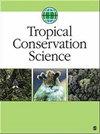加纳中部穴居蝙蝠的多样性和保护
IF 1.6
4区 环境科学与生态学
Q2 BIODIVERSITY CONSERVATION
引用次数: 2
摘要
加纳是非洲大陆六个蝙蝠多样性热点地区之一,但它的洞穴还没有被充分探索,因为它们是蝙蝠的栖息地。研究目的我们旨在评估加纳中部5个洞穴的物种组成和多样性,并确定那些需要立即保护的洞穴。方法2010年10月至2012年7月,我们在加纳中部上几内亚森林和萨凡纳地区使用雾网捕获了102个通宵的蝙蝠。结果共记录到蝙蝠9种10226只。PERMANOVA表明,不同洞穴的物种组成存在显著差异。SIMPER分析显示,各洞穴间的主要区别种为非洲蕨和jonesi,所有洞穴均以Hipposideros cfr . ruber占优势。蝙蝠洞穴脆弱性指数(BCVI)显示,上几内亚森林地区的Mframabuom洞穴是受威胁物种的高优先级洞穴,但受到高度干扰。其余洞穴被确定为中等优先洞穴。结论研究结果表明,为了实现国家保护目标,需要进一步的研究和立即的保护策略。本文章由计算机程序翻译,如有差异,请以英文原文为准。
Diversity and Conservation of Cave-Roosting Bats in Central Ghana
Background Ghana is one of the six bat diversity hotspots on the African continent, yet its caves have not been fully explored for the bats they host. Research Aims We aimed to assess the species composition and diversity of five caves in central Ghana and identified those needing immediate conservation attention. Methods Using mist-nets, we captured bats over 102 full nights between October 2010 and July 2012 from the Upper Guinean forest and Savannah regions in central Ghana. Results A total of 10,226 bats belonging to nine species were recorded. PERMANOVA suggested significant variation in species composition among the caves. A SIMPER analysis revealed Coleura afra and Hipposideros jonesi to be the main discriminating species between caves, with a dominance of Hipposideros cf. ruber in all caves. The Bat Cave Vulnerability Index (BCVI) revealed Mframabuom cave from the Upper Guinean forest region as a high priority cave hosting threatened species, yet highly disturbed. The remaining caves were identified as medium priority caves. Conclusion The results of the study suggest the need for further research and an immediate conservation strategy as essential for approaching national conservation goals.
求助全文
通过发布文献求助,成功后即可免费获取论文全文。
去求助
来源期刊

Tropical Conservation Science
BIODIVERSITY CONSERVATION-
CiteScore
3.60
自引率
5.90%
发文量
16
审稿时长
>12 weeks
期刊介绍:
Tropical Conservation Science is a peer-reviewed, open access journal that publishes original research papers and state-of-the-art reviews of broad interest to the field of conservation of tropical forests and of other tropical ecosystems.
 求助内容:
求助内容: 应助结果提醒方式:
应助结果提醒方式:


